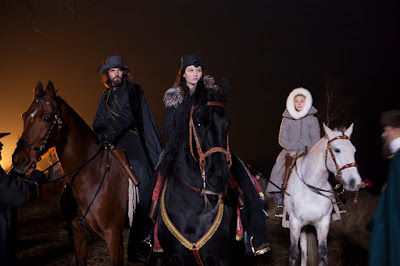I
recently received another set of questions from my friend and fellow
blogger at the stunningly beautiful
Almond Valley! This time, the questions are
Yule themed, as befits the season... So, here goes! All sorts of
musings about the holidays. :)
1. Are
you going to give any presents you made by yourself?
I’m
thinking... chocolate! Yes, perhaps; if I can find the time. It's not looking very good at the moment...
2.
What’s the best present you’ve ever received that was made by the
person who gave it to you?
This
one’s easy! Woollen socks knitted by my mother-in-law. My feet are
always cold. Always. My mother-in-law knits awesome socks; they’re
pretty and soft and warm. They’re a gift that I use every day
(yes, even in summer) and particularly special since she makes them
herself – I could never knit a sock!
3. Have
you ever made your own advent calendar?
I used
to make them as a child. Now I no longer actually make them, but we
have one which is basically 24 boxes that have to be filled... with
chocolate! :) And little notes for my daughter that tell her to go
treasure hunting to find tiny surprise presents.
4. What
puts me in the mood for Yule is...
Candles.
Music (I particularly love Loreena McKennitt’s Midwinter music).
Scents – gingerbread, cinnamon... The first mug of mulled wine (or
glögi).
5.
What’s your best Christmas recipe?
A date
cake laced generously with rum. My DH actually bakes them, but since
I developed the recipe, I think I can claim some credit. ;) This cake
is extremely moist and sort of caramelly because of the dates... it’s
almost as good as chocolate cake!
6. Have
you ever spent the holidays abroad? Where and what was it like?
I’ve
spent the holidays in Canada, first in 1995 with my mother, father
and sister, and then in 2004 with my husband. The first one was
lovely, some traditions, some new things, and the second one was actually our first holiday without our families, just the two of us. We had some decorations, lots of candles, and a friend
even gave us a tiny tree! We had smoked salmon and rye bread that I’d
baked... and I cooked a turkey breast with plenty of pesto! Not very
traditional, but we thought it was delicious. We had eggnog and
chocolate... I missed sauna, but we took a bubble bath in candle
light, and it was lovely. I had an elf costume that my DH found
very... shall we say, entertaining. ;) There was much reading and
relaxing and no obligations to do anything. Definitely one of the
best holidays ever!
7. The
prettiest flower arrangement for Christmas is made how?
Are you
asking me? I have no idea! As for typical flowers of the season, the
amaryllis is gorgeous, but the one flower I always want to have is
the hyacinth! Their scent is one of the scents I associate with the
season, so I usually get some just because of that.
8. Your
most beautiful DIY Christmas decoration?
Hmm...
I’m going to say the gingerbread wolf wood! This is a bit of a private
joke... our family name, Susimetsä, means wolf forest, so, last year
we decided to make this - three wolves and a forest:
9. Do
you have any new ideas for wrapping gifts?
I’m
afraid not...
10.
What’s your Christmas tree like?
It’s
an old (almost 15 years!) plastic tree. The ornaments are mostly red
and gold... we have some very nice ones we brought back from Canada
and ornaments that my mother collected... but we haven’t even taken
them out of their boxes for years, not since our daughter was born.
Accidents happen, and it’s better to keep those precious ornaments
wrapped up and waiting. We have enough ornaments to cover the entire
tree even without them.
11.
Holidays aren’t the holidays without...
My
husband and daughter. As long as I’m with them, we could spend the
holidays anywhere. If I have to mention something else... well, you
guessed it: books and chocolate!












